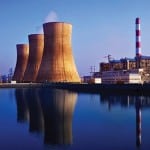India, a country that plans to fuel its current level of gross domestic product growth of between 8% and 9% with massive, mostly coal-fired power capacity additions over the next decade, in March commissioned an 800-MW supercritical unit at the first of India’s government-envisioned ultra-mega power plants (UMPP). Tata Power, the country’s largest integrated private utility, put online Unit 1 of the five-unit 4,000-MW Mundra UMPP in Gujarat State, just 48 months after construction began on the project (Figure 1).
 |
| 1. The start of something big. India’s Tata Power put online Unit 1 of the five-unit 4,000-MW Mundra ultra-mega power plant (UMPP) in Gujarat State. The project is the first of a series of 16 UMPPs envisioned by the Indian government to ramp up power capacity and address chronic power shortages. Some projects will have dedicated captive coal blocks while others will be built closer to ports and will rely on imported coal. Courtesy: Tata Power |
The unit had been ready for grid synchronization since last June, the company said in a statement, but it was awaiting a transmission system connection from India’s national grid operator, the Power Grid Corp. of India Ltd., a project that was commissioned on Sept. 29. Work on Units 2, 3, 4, and 5 was all on track and “progressing well,” Tata said. The project located south of Tunda Wand village in Mundra Taluka, Kutch district of Gujarat, will be operated by Tata subsidiary Coastal Gujarat Project Ltd. and is expected to supply five power shortage–stricken Indian states: Gujarat, Maharashtra, Rajasthan, Haryana, and Punjab.
In 2006, India announced it would fast-track a series of 16 ambitious supercritical coal-fired projects, each with a capacity of 4,000 MW, to help boost power capacity by at least 100,000 MW by the end of the five-year 11th plan (which ends this year). Each UMPP is expected to require an investment of about $4.5 billion or more, it said.
Only four projects have been awarded so far on a build, own, and operate basis. In addition to Tata’s Mundra in Gujarat, three are being developed by Reliance Power: the Sasan UMPP in Madhya Pradesh, Krishnapatnam UMPP in Andhra Pradesh, and Tilaiya UMPP in Jharkhand. The first 660-MW unit at Sasan is expected to come online in January 2013, just as the last Mundra units will be commissioned. At Krishnapatnam, however, where Reliance had planned to build six 660-MW units, work has been paused since last June. Reliance cited a new regulation from Indonesia—from which it imports its coal—that prohibited sale of coal, including to affiliate companies, below benchmark prices.
The Tilaiya project, which would also comprise six 660-MW units and is expected to come online between May 2015 and June 2017, is being built at a coal pithead (mine mouth) and has dedicated captive coal blocks—unlike the other three projects, which will rely on imported coal.
Future UMPP projects may be sited in this way, or closer to ports, as India battles chronic coal shortages. Though the country has large coal reserves, domestic mining companies are struggling to keep up with demand needed to sustain its existing coal plants, which account for 55% of India’s generation.
India’s capacity frenzy extends far beyond UMPPs, and even bigger coal plants are slated to come online over the next decade. This March, international business conglomerate Adani Group’s power arm, Adani Power, synchronized the fifth supercritical unit of its 4,620-MW coal-fired power plant, also in Mundra, Gujarat, making it one of the biggest privately owned coal plants in the world (Figure 2). The plant was developed in four phases and comprises four units of 330 MW each and five supercritical units of 660 MW each. Construction began in 2008 and full commissioning is expected later in 2012. Like Tata’s Mundra UMPP, Adani’s plant will also use imported Indonesian coal.
 |
| 2. Clash of the titans. In March, Adani Power put online the fifth supercritical unit of its 4,620-MW coal-fired power plant that is sited in Mundra, Gujarat State, adjacent to Tata Power’s recently commissioned 800-MW supercritical unit of its ultra-mega power plant. This image shows fishermen walking in front of the Tata Mundra plant (left) and Adani Power project (right). Courtesy: Bank Information Center Trust |
The Mundra plants are two of India’s first supercritical units in an existing 105-GW coal fleet, though dozens more advanced coal plants aiming for reduced fuel consumption are in the pipeline. In late February, national generator NTPC, for example, announced it would build India’s first coal-fired 800-MW ultrasupercritical thermal power plant project by 2017. Meanwhile, India’s 12th plan calls for 60% of coal capacity additions to come from supercritical plants.
And India is not alone: According to the International Energy Agency’s (IEA’s) recently released World Energy Outlook, the past five years have seen increased shares of both supercritical and advanced coal generation technologies, such as ultrasupercritical and integrated gasification combined cycle technology. In 2010, roughly three-quarters of coal-fired capacity worldwide was subcritical, compared with close to 85% in 1990. About 20% was supercritical, and only 3% consisted of advanced technologies. The agency projects that advanced technologies will make up a much larger share of future coal plants, which are expected to account for around 27% of the total new additions to generating capacity worldwide between 2011 and 2020, and around 22% between 2011 and 2035.
One key factor that impedes the deployment of more efficient coal-fired generation is the “often relatively expensive” levelized cost basis, the IEA says. “The thermal efficiency of an ultra-supercritical plant is typically up to 50% higher than that of a conventional subcritical plant. But the capital and maintenance costs are higher, which can make the subcritical plant the cheaper option at low coal prices, where there is no penalty for CO2 emissions or when regulated electricity rates result in losses for the producer.”
Agency data showed, for example, that in China, a typical ultrasupercritical plant today had capital costs only 15% higher than those of a supercritical plant, yet subcritical plants continued to make up a substantial proportion of new coal-fired capacity. Other factors that markedly affect which technology is used in new plants include fuel quality (local coal may have high moisture, ash content, or impurities); the technical capability and experience required to construct and operate such plants; the longer planning and construction lead times of more complex plants; the size of the unit; and local conditions such as the availability of water. “Taken overall, the best-available technology may not be the cheapest or most practical solution,” it notes.
—Sonal Patel is POWER’s senior writer.










